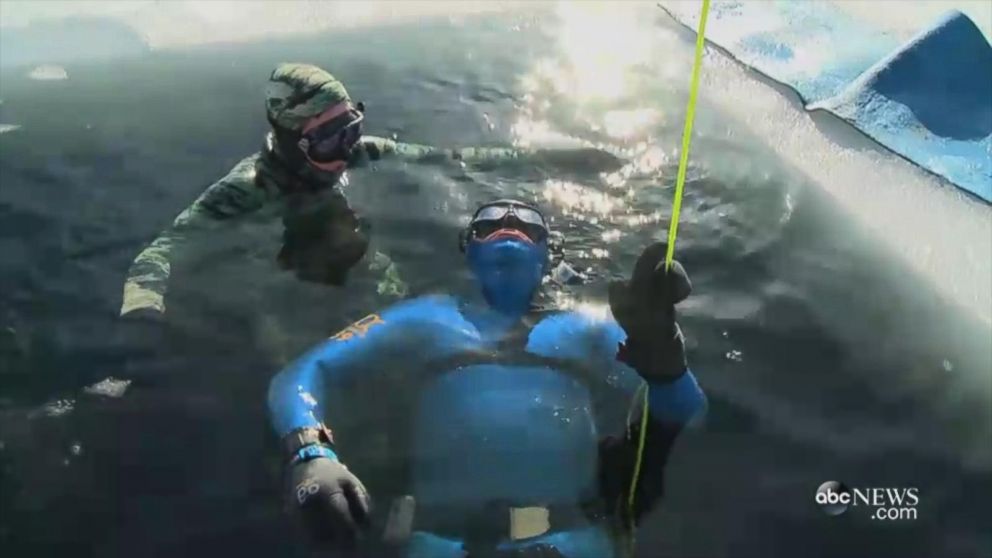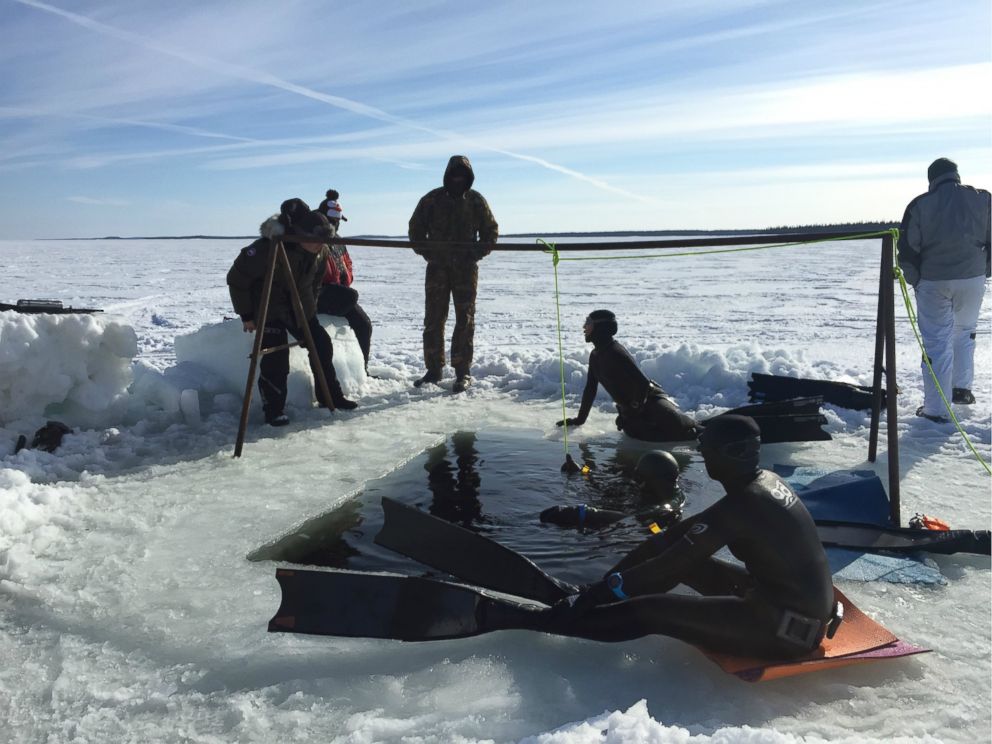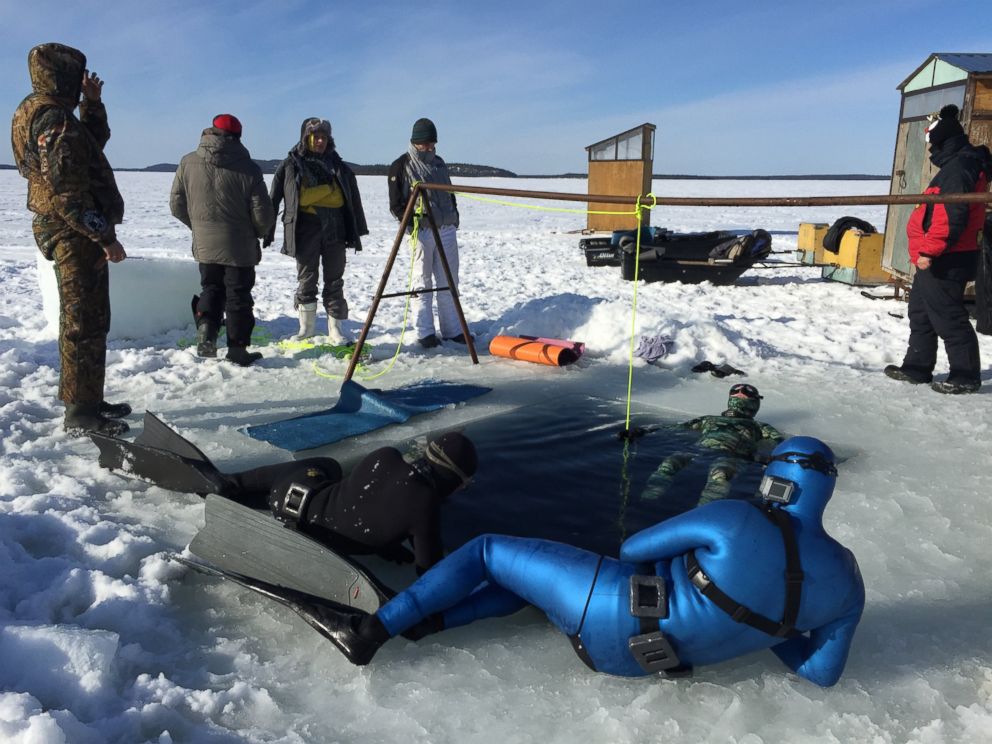Russian freedivers dive below Arctic ice without scuba gear (for fun)
The divers hold their breath for minutes to find the "state of quiet there."
NILMA GUBA, Russia— -- At first glance, the appeal may not be obvious.
You’re 33 feet underwater beneath a solid roof of ice. You’ve been holding your breath for three minutes, surrounded by darkness. Somewhere above is the only way out: a 6-foot hole in a vast ice ceiling. But from down there, you can’t see it.
For many, it’s the stuff of nightmares. But this is what brings a group of Russians every spring to this spot on the White Sea inside the Arctic Circle: free diving, the extreme sport in which people dive to extraordinary depths without breathing equipment, just holding their breath.
Normally, free diving is practiced in warm open seas; here it’s done under the Arctic ice.

Even without ice, free diving is one of the world's most dangerous sports. Divers aim for depths usually below 100 feet, where pressure compresses their lungs into small fractions of their normal size, potentially causing vessels in them to burst. Lack of oxygen can cause blackouts. Divers can temporarily lose motor skills, and below certain depths, it becomes impossible to tell which way is up. Deaths occur every year.
Imagine, then, free diving while knowing everything above you is almost entirely sealed.
“Of course, that leads to fear,” said Konstantin Novikov, a free dive trainer leading the group. “You know precisely that you just have a few places where you can get out.”
The dive center where they stay is in the tiny village of Nilma Guba, nestled on an icebound archipelago that locals have nicknamed Russia’s unsinkable aircraft carrier because of the concentration of military bases around it.
The center is the only training base in the world for under-ice free divers. The world's greatest free diver, Natalya Molchanova, who vanished underwater last year, once dived here.

The dive site is far out on the frozen sea, a floating platform stretching from horizon to horizon. To reach it, the divers bounce along on sleds pulled by snowmobiles.
Chainsaws are needed to access the water, and the snowmobiles haul the ice blocks out of the dive holes. The divers wear thick drysuits that let them stay in the water for about 40 minutes at a time.
The record dive here is about 213 feet, the equivalent of swimming down a 15-story building or more than an Olympic swimming pool turned on its end. The divers this time are mostly beginners, and they’ll start at about 33 feet and move down to nearly 100, then perhaps 164.
There are two kinds of dives: going straight down and swimming under the ice from one hole to another, sometimes as much as 65 feet apart. Between the holes, divers have to hold their breath for up to three minutes — no big deal for free divers, among whom the record is nine minutes. Still, there's no easy exit if you need to take a breath.

Diving straight down is more unnerving. Because of the ice covering, as divers descend, it becomes dark far more quickly than in the clear tropical seas where free divers normally swim. At 98 feet, it’s pitch black, “like in a photo darkroom,” Novikov said.
Drifting away from the hole has obvious potentially lethal consequences. To prevent this, divers are attached to a rope. But even with their thick suits, they can feel the cold.
As the divers descend, they have to force air from their lungs into their mouths to equalize pressure in their ears without, of course, opening their mouths.
“I thought it was kind of hell the first time I did it,” Oleg Zhumukhanov, a diver, said, laughing.
To achieve it, free divers put themselves into a condition of total physical relaxation, using a technique the Russian divers call deconcentration. Before the dive, they lie in the freezing water, slowly pulling air in and out, trying to give thought the slip.
“The state of relaxation is needed to shut off the head,” Zhumakhanov said. ‘In theory, the brain uses 30 percent of your energy. When you dive deep, it’s necessary to turn off as many systems that need oxygen as possible.”
Below about 65 feet, a phenomenon called negative buoyancy occurs: The body ceases to float and instead sinks, plunging in slow motion into the dark, cold deep. More than 100 feet underwater, the divers’ heartbeats often slow to half their normal rates. Divers describe it as a dreamlike state.
“It’s a little bit like mysticism,” Zhumakhanov said. “Because the person moves in an altered state of consciousness.
“It’s a striving toward the embryonic, to the place where we all came from,” said Dmitrii Titov, another diver. “A baby in the mother’s womb doesn’t have an oxygen tank.”
The appeal of the ice, the divers say, is its beauty. The world underneath is a weird glowing green place, with ice boulders and huge geometric shards, packed together by the currents. From below, the small hole is barely visible, edged with gold. Everything else is solid.
“It looks like a window ... like a window to another world,” first-time free diver Ksenia Finugenova said.
In normal life, Zhumakhanov runs an IT business. Two of the other divers practice osteopathy. Titov is an underwater hunter.
None are much fazed by the cold water, and they note that it’s common in Russia to swim in ice holes.
They say the imposed calm is what they’re looking for.
“It’s a state,” Titov said, “because without a state of calm inside, to dive to a great depth is not realistic. Only stopping thinking allows you to dive to a good depth and experience the state of quiet there.
“I think it’s for that, people go to the deep.”




